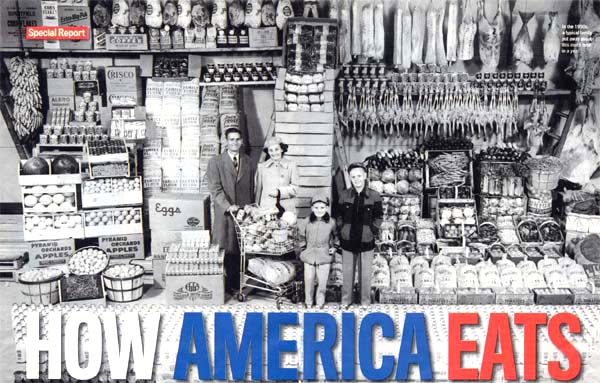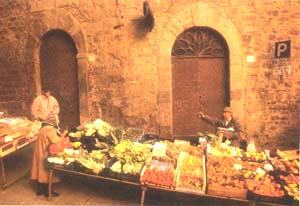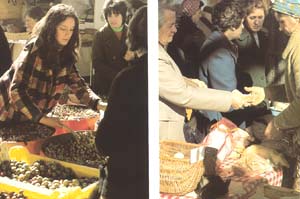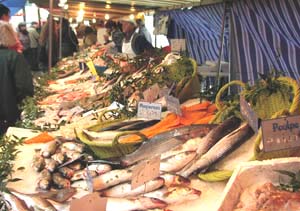 |
Right to Life - Environment
What America Eats:
A New Tendency Sprouts
Marian T. Horvat, Ph.D.

US News & World Report, August 15-23, 2005
|
This picture presents a typical American family in the 1950s and the food it consumed in a year. It was an illustration in the feature article “What America Eats” in the August 15, 2005 issue of US News & World Report.
The first time I came upon this picture, however, was about 20 years ago when I was translating an “Ambiences, Customs, and Civilizations” article by Prof. Plinio Correa de Olivera (Catolicismo, March 1959). I didn't fully understand his comments at that time. Now, I see that he was foreseeing the situation we are in today.
He agreed that the first impression the picture gives is one of healthful abundance. But then he suggested a more careful analysis of the picture. Almost all the foodstuff, he noted, is preserved, canned, shipped, or boxed. Everything – both the processed and natural provisions – come to the table via a whole chain of intermediaries.
He then raised doubts about the harmful long-term effects for man in the consumption of food manipulated by middle-men. He asked several questions that many persons are asking today: Is there really nothing wrong with such “de-naturalization”? Shouldn’t there be a limit to the extensive and universal imposition of technology in matters of food?
Today, the picture of a year’s food consumed by an average family would probably be more rather than less than what is pictured above. It would include large sections of pizzas, hamburgers and fries, tacos, candy bars, and chips. Next to the long line of milk bottles and orange juice in the front rows would be equal or greater numbers of soft drink cans. That is to say, there would be even greater quantities of processed foods as well as something that hardly existed in the diet of the average 1950s’ family – junk food. Ironically, with all this food, people are underfed – the food they eat does not truly nourish them, and can even make them feel sick.
In 2005, we are, indeed, feeling the long-term effects of a non-natural diet concocted by an exaggerated technology. Americans have a growing problem of obesity not just among adults, but even among children – latest figures say 20% of children are obese. This was an unthinkable figure at the time the picture above was taken in the 1950s.
Serious studies are showing that diet is one of the causes of many chronic diseases. More than 65 million Americans suffer from high blood pressure, and scientists predict that number is sure to rise. Cancer continues to be the number 2 cause of death, with more than 1.3 million new cases recorded in 2004 alone. The American Diabetes Association states that there are 18.2 million people in the United States, or 6.3% of the population, with the disease. The number of chronic illnesses caused by immune system deficiencies and food allergies are also soaring. I am sure there are other sicknesses and diseases in part caused by artificial, processed foods.

Saturday morning market in Cortona

Shopping for fresh produce and poultry in Languedoc

The Paris fish market |
In addition, there is everyday experience of a general degeneration of health. Many people I talk to today do not feel well. Some complain of a lack of energy, others of headaches, yet others of nervous problems or depression. While some are trying to resolve the problems with medicine, growing numbers are taking vitamins and supplements, or on some special diet to try to regain their health or ideal weight. Simply put, there is increasing suspicion that the processed and “unnatural” food chock-full of preservatives and artificial flavorings has a direct relation to poor health.
In his article, Dr. Plinio contrasts the picture above with a market place in Bahia, Brazil. I don’t have that picture, but I am using some similar photos:
- Saturday morning market in Piazza del Duomo in Cortona,
- shopping for fresh produce and poultry in Languedoc,
- the famous open fish market in Paris.
The point to be made is that these are foods that do not pass through a whole complicated chain of intermediaries and go through all kinds of artificial processes to remain edible. They do not spend long hours stiff and frozen in cold storage. Fresh, full of flavor, they go from the field to the market to the kitchen, where they are transformed into nutritious and tasty dishes. The food is flavored, healthy and nourishing, and the experience of buyer and seller is picturesque, charming, and human, reflecting an authentic organic way of life.
In the 1950s, these market places might have been considered backward and inconvenient by American shoppers already spoiled by the supermarket and canned foods. Today, however, we find a growing number of U.S. cities and villages establishing their own open markets or farm co-ops offering organic fruits and vegetables, farm eggs, raw milk, natural honey, and so on. Many young mothers are learning the Old World housewifery skills of making bread, churning butter, and growing herbs and vegetables so that their families will be healthier.
Who could have imagined this growing enthusiasm for old-fashioned markets and customs? In my view, it indicates a healthy reaction against the industrial revolution that was seizing control over man and distancing him from the good aspects of nature not only in matters of food, but in almost everything.

Posted September 30, 2005
|
Right to Life | Cultural | Hot Topics | Home | Books | CDs | Search | Contact Us | Donate

© 2002- Tradition in Action, Inc. All Rights Reserved
|
 |

|